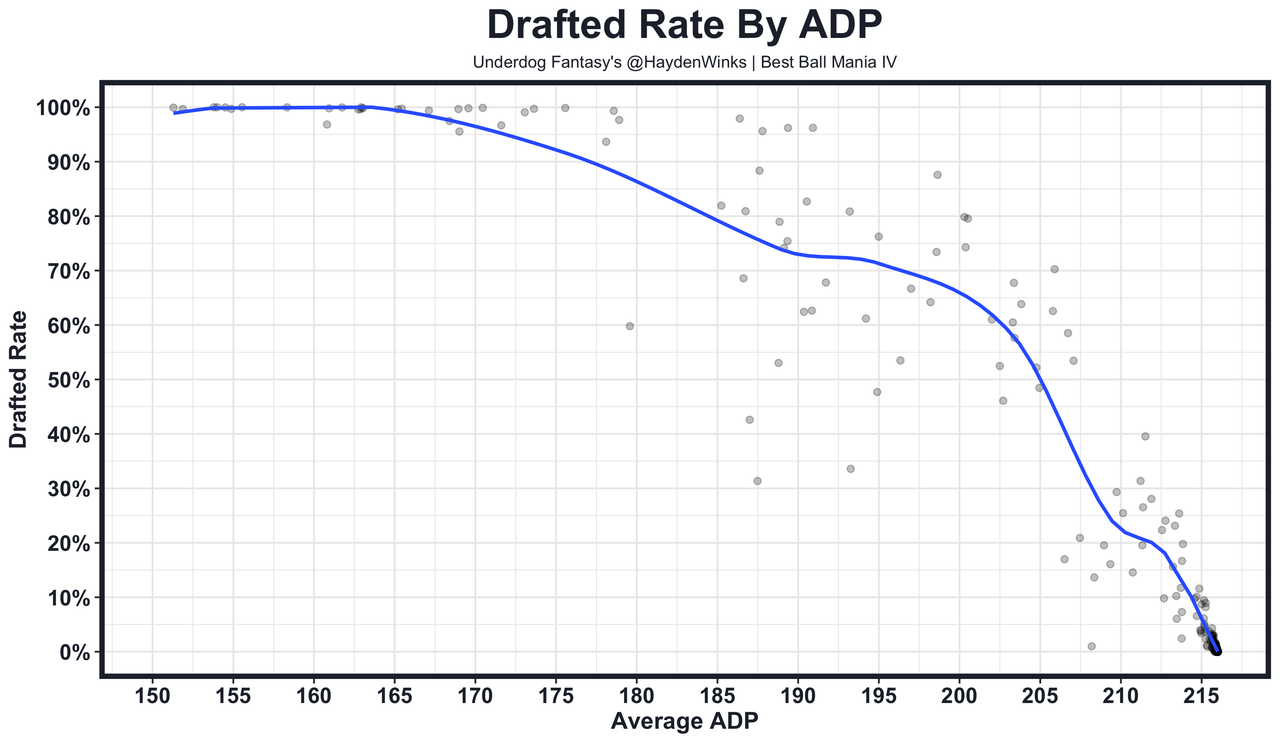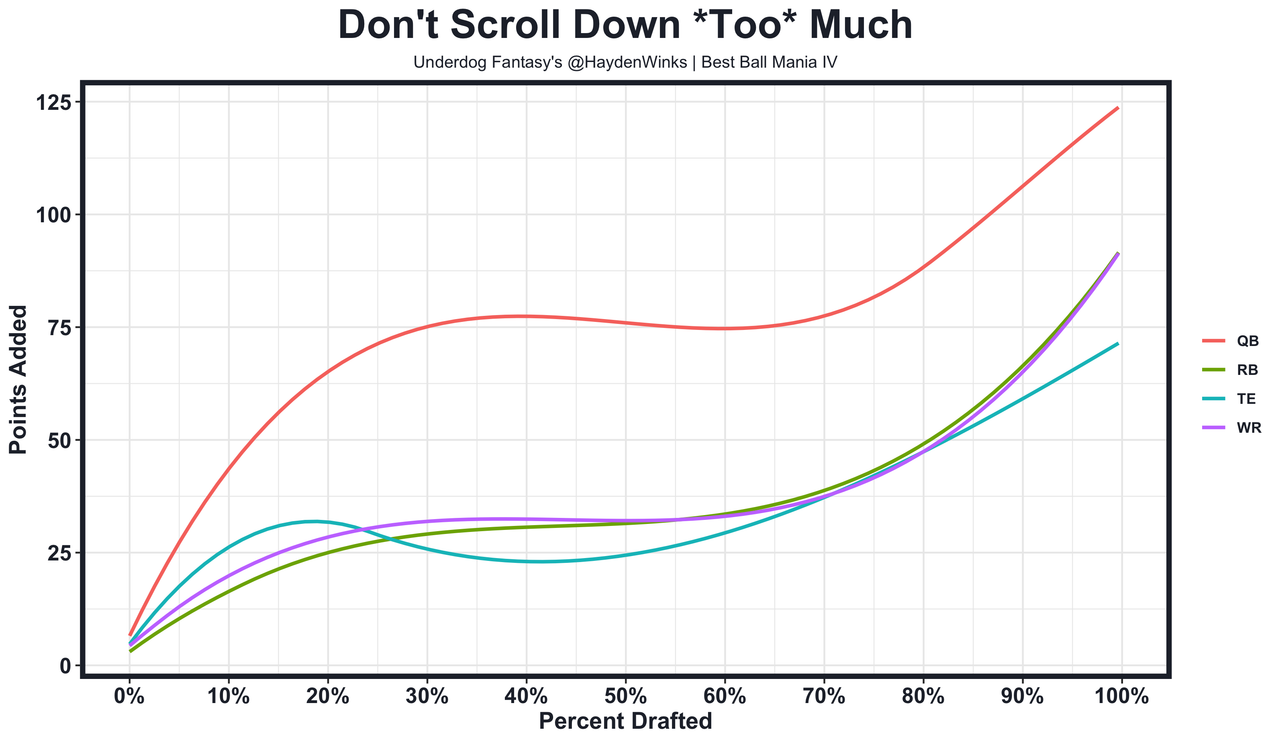What Has Worked In All 4 Years Of Best Ball Mania
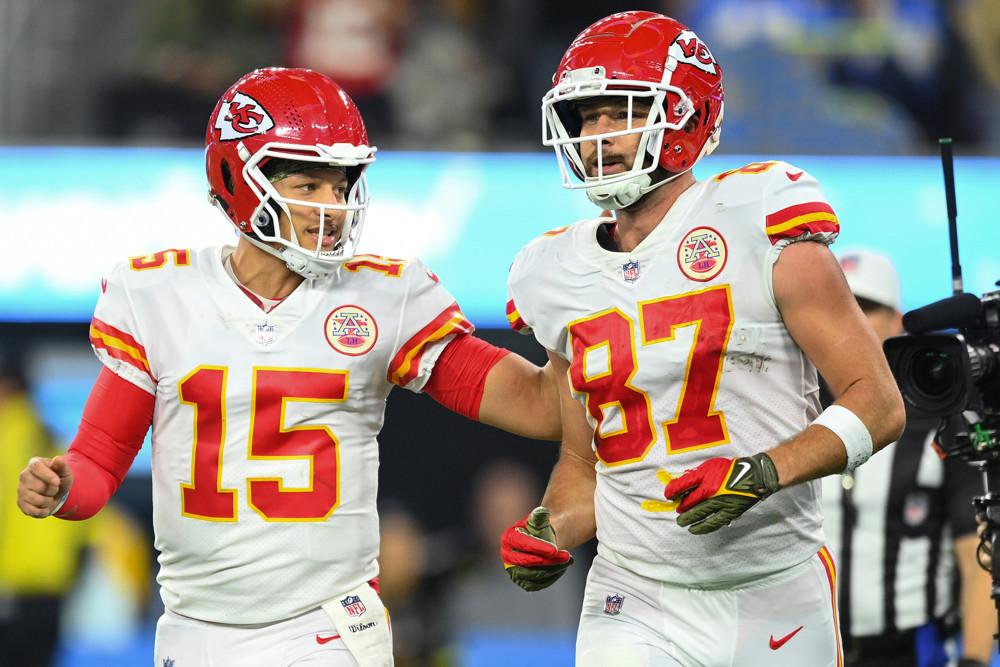
Best ball can be as simple or complicated as you want it to be. Some just "pick the best plays". Others will ponder the exact percentage a Week 16 bring-back correlation between a TE and opposing backup RB has, while they try to win $1.5M in Best Ball Mania V. There is time to discuss the hyper-specific details of contrarian builds, but this column isn't set out to do that. Instead, I'm on a mission to see what has worked every single year of Best Ball Mania's young journey. If it's worked 4-straight years, then we might be onto something here (if we apply things correctly).
To do so properly, we need to understand precision vs. accuracy.
Precision is trying to zoom all the way in and make a very specific prediction. Accuracy is aiming to be generally correct on a broader target. For example, the fantastic All In Podcast mentioned this topic while chatting about stock trading. Back in 2012, an investor loved Macy's individual numbers while trying to be precise on their trade, but the only thing that mattered in that era was that Amazon was going to replace big box stores over the next decade as the internet became more-and-more complex and generally used. It was more valuable to be accurate in the zoom out (fade big box retailers) than to be more precise in the zoom in (Macy's numbers look good). For best ball, the closer we zoom into a trend, the noisier it will be. If we study what has won in the first round over the last four years of Best Ball Mania, then we'll just follow a trend that likely doesn't exist moving forward. If we study what has happened through Round 18, then we have a much bigger sample size and will have more accuracy in establishing a trend that'll remain true for years to come.
For example, just look what would've happened if you only drafted RB-RB teams after BBMI and BBMII hits. Or look what would've happened if you blindly faded Round 3-5 RBs after BBMI and BBMII because of the "RB dead zone" without acknowledging how ADPs have changed. These zoomed in trends and strict definitions of strategies often lead us the wrong way:
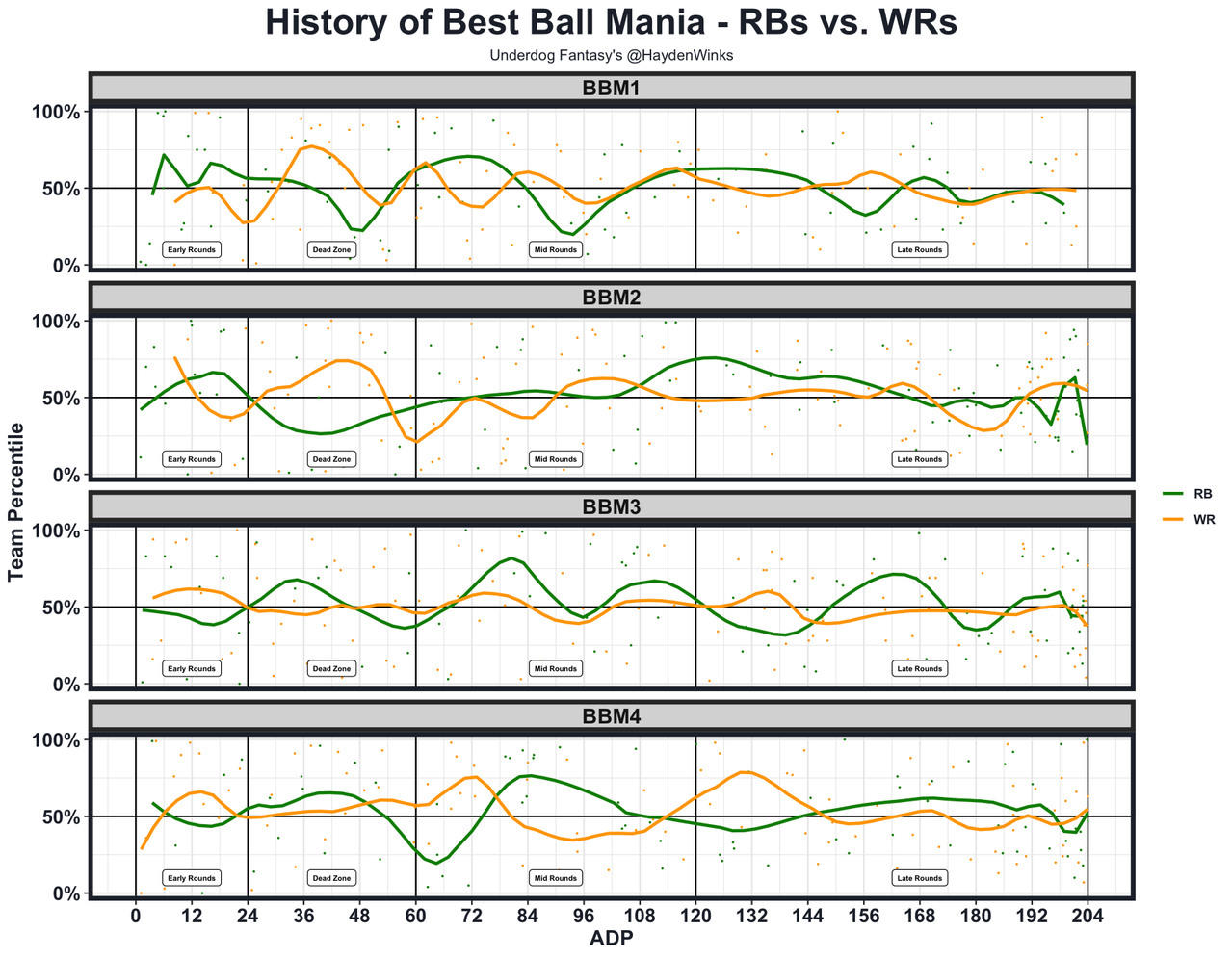
One reason why data gets more predictive the further we zoom out on the draft board is because "diminishing returns" is a key part to the best ball formula, especially when we're bound to a specific number of rounds (18) and starting spots (QB-RB-RB-WR-WR-WR-TE-FLEX). That's why I'm most confident in giving recommendations on what roster construction our teams should have through 10 or 18 rounds, rather than saying what you should do through 2 rounds of a draft. In fact, we're better off looking at upcoming season player projections than looking at what's worked in previous years when it comes to which players to draft in the very earliest rounds. This same concept applies to the onesies, too. There are fewer elite QBs and elite TEs, so "trends" at those positions are prone to crazy year-to-year noise compared to WRs and RBs where there are dozens of elite options annually. And like I just mentioned, the WRs and RBs trends are still prone to noise.
Another example of being too precise would be studying the previous Week 17 results in particular, rather than looking at the entire season of data. The scoring system doesn't change in the regular season. We still take the optimal lineup with one flex throughout the regular season. It's not that Week 17 doesn't matter (of course it does), but only looking at Week 17 results is trying to be too precise, even if our draft goal is to build a Week 17 upside team.
The last example of trying to be accurate would be looking at average or above-average results rather than only looking at what the top 1% of teams are doing (at least until we get more seasons under our belt to build up that sample). We of course need top 1% results to get the big pay day in these tournaments, but studying what the above-average teams are doing will generally lead us to what the top 1% of teams will be over the next decade of tournaments. Unfortunately, there isn't a sure-fire way to do this. Regular season advance rate? Regular season points above average? Top 5% teams only? Week 17 scoring only? No singular stat is going to solve best ball by themselves, and a lot of the takeaways would be the same if we changed "advance rate" to "average fantasy points" anyways.
The important part is to be generally accurate with what's known to work over a big sample, then it's on us to apply game theory on how to tinker our picks once we're breaking ties in the draft room. Today's goal is to zoom out and create some general guidelines.
What Has Worked For Fantasy WRs...
Having 4-5 WRs Through Round 7... This has been one of the best strategies every year and something I coined as the "Golden Rule Of Best Ball" back in 2021. Compared to the other fantasy positions, there are fewer late-round WR breakouts and fewer stone-cold busts. That means more of the spike weeks at the position come from the early- to mid-rounders. In BBMIII and BBMIV (which happened to be great for WR-heavy builds because RBs and TEs did poorly in early rounds), it's been very good to even have a 6th WR through Round 7, but in BBMI and BBMII (which happened to be solid for RB-heavy builds), it was acceptable to only have 3 WRs through Round 7. But in all 4 years, sticking with 4-5 WRs has been very good. The good news for those reading this is that only 49% of teams in BBMIV had 4+ WRs through Round 7. It's probably the biggest and/or most reliable edge in best ball right now, and it's not hard to complete. It also doesn't even require going crazy with WRs early either. There is room for a few detours along the way.
Having 4-6 WRs Through Round 10... The same concepts from the paragraph above apply here, but I wanted to point out that having an 7th WR by Round 10 has been a below-average strategy. The primary reason is "diminishing returns", which is defined as proportionally smaller profits/benefits derived from something as more money/energy is invested in it. For best ball, the 7th WR this early is the breaking point. Read "Draft More Best Ball Teams With Only 6-8 WRs" for more on this topic, especially if you're in the Heavy Early WR crowd.
Having 7-8 WRs Through Round 18... How many WRs you finish your draft with should depend on how early you drafted your WR1, WR2, WR3, and WR4. If those were very early round selections, then 7 WRs is a target (with 6 WRs being viable in certain builds). If those were primarily mid-round selections, then 8 WRs is a target (with 9 WRs being viable in certain builds).
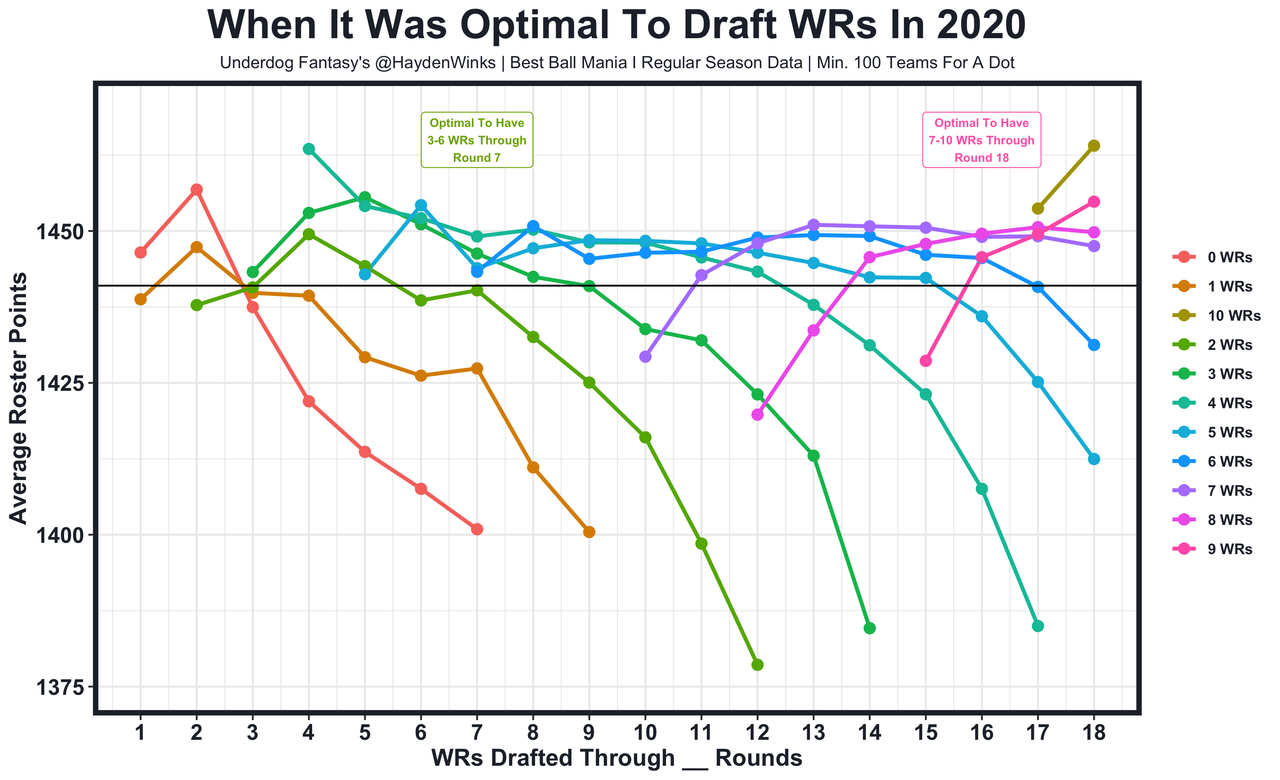
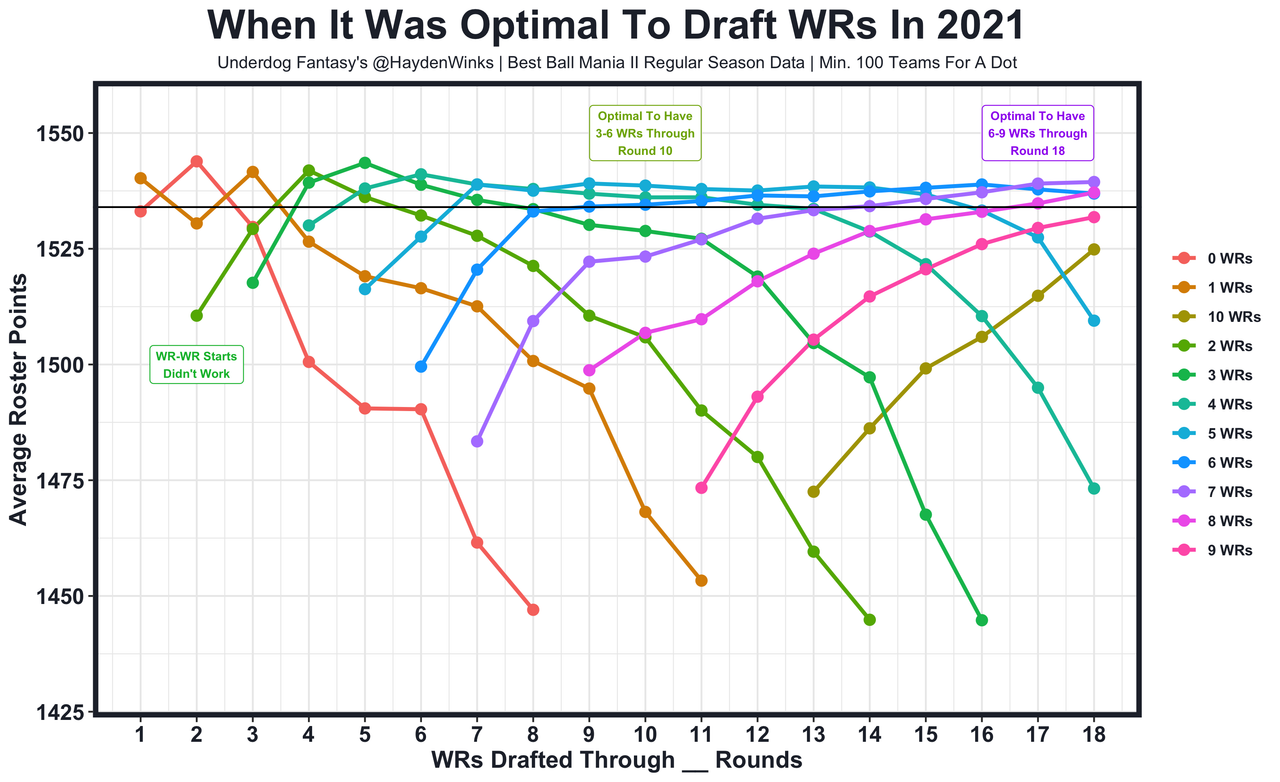
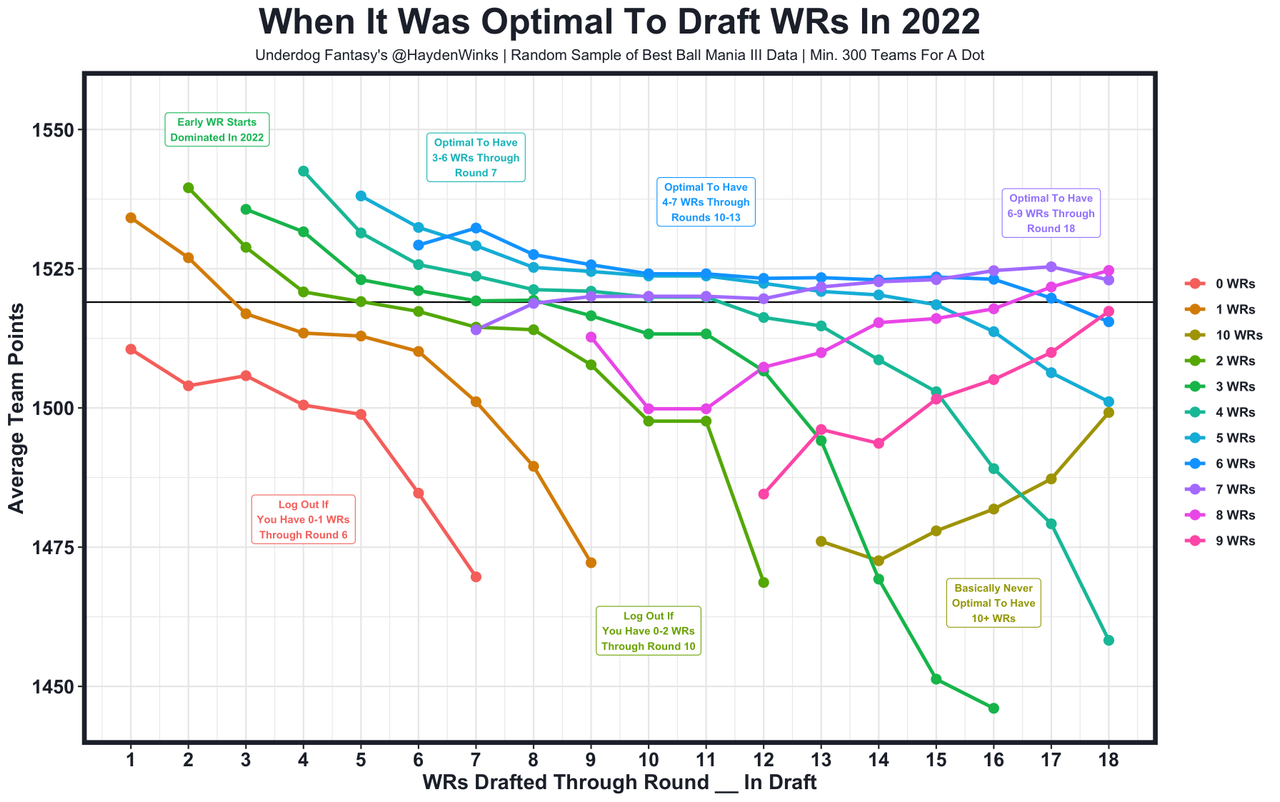
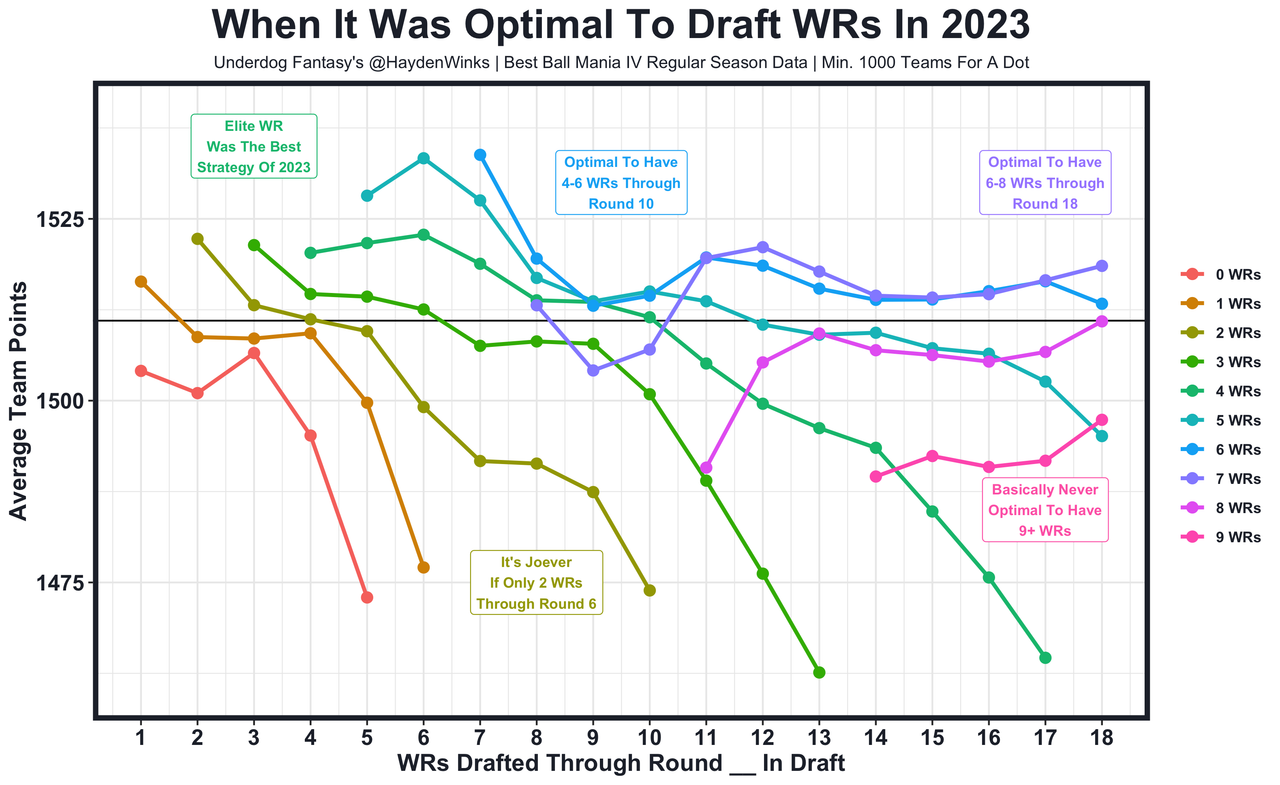
What Has Worked For Fantasy RBs...
Having 1 RB Through Round 4... There hasn't been an exact blueprint on early-round RB strategy. In BBMI and BBMII, teams that started with RB-RB had great seasons, but they've been very bad over the last two seasons. It's fair to say the quality of the RB1 talent was better in 2020 than it was in 2023. So what do we do moving forward? Well, we can look at upcoming season projections to decide if it looks like a good year or not to draft some RBs, and we can zoom out a bit when looking at the trends. If we look at Round 4-5 instead of Round 1-2, then we have a bigger sample. In Round 4, it's been optimal or close to optimal to have 1 RB every season. Some years it's been better to have 2 RBs. Others, 0. But having 1 RB through Round 4 has been a solid choice every year so far.
Having 3-4 RBs Through Round 10... If we zoom out even more, then the RB guidelines become clearer because the sample is bigger and diminishing returns begin to kick in. Having 3 RBs through Round 10 has been the second-best option in 3-of-4 years, while having 4 RBs has been the best option in back-to-back years and performed well in BBMI and BBMII, too. This logically checks out because about half of the "flex" spots are filled by a RB.
Having 5-6 RBs Through Round 18... Finishing with 6 RBs has been optimal in 3-straight seasons, while 5-RB teams has been first or second every season so far. We should decide how many RBs we want based on how early we drafted our RB1, RB2, and RB3 because of diminishing returns. In fact, 4-RB builds have been alright when deployed properly (if you went full RB Bro). Same with 7-RB builds when tied in with Zero RB starts. Ultimately, there is a lot of freedom with when to draft RBs. What strategy is best will likely bounce around year over year.
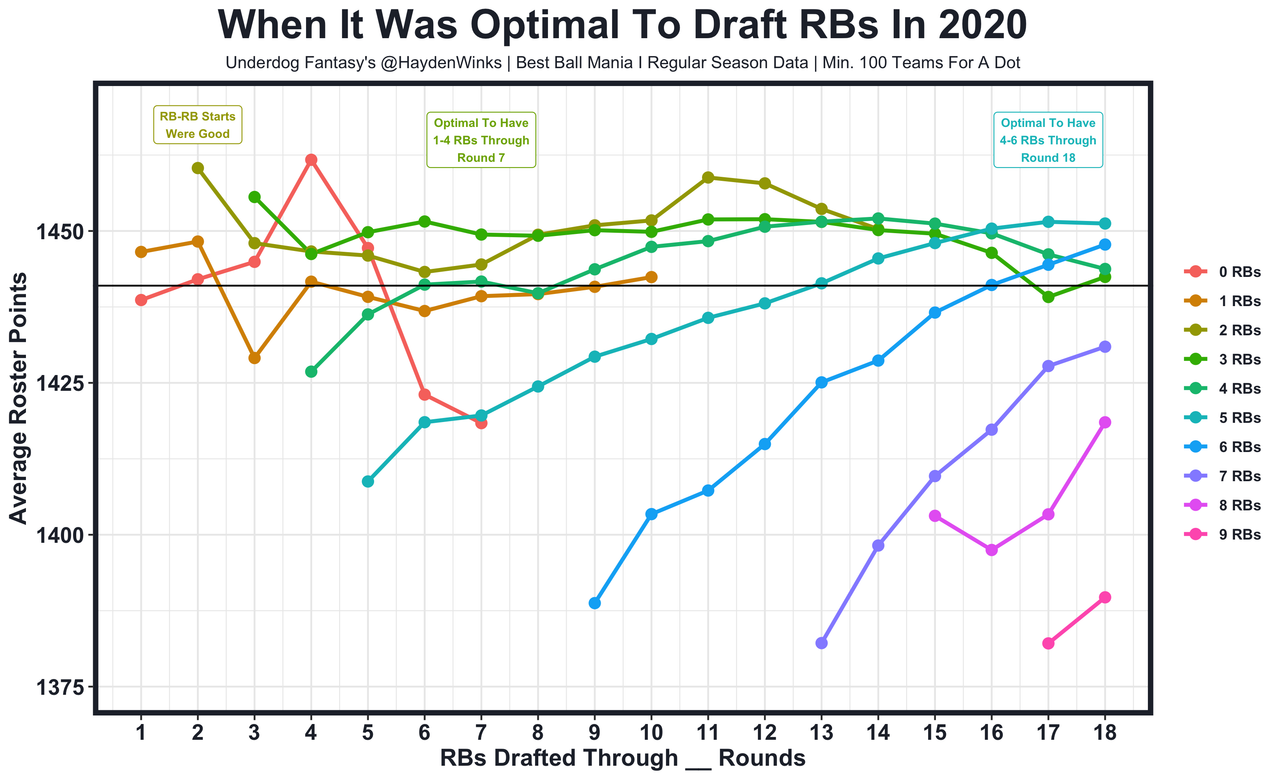
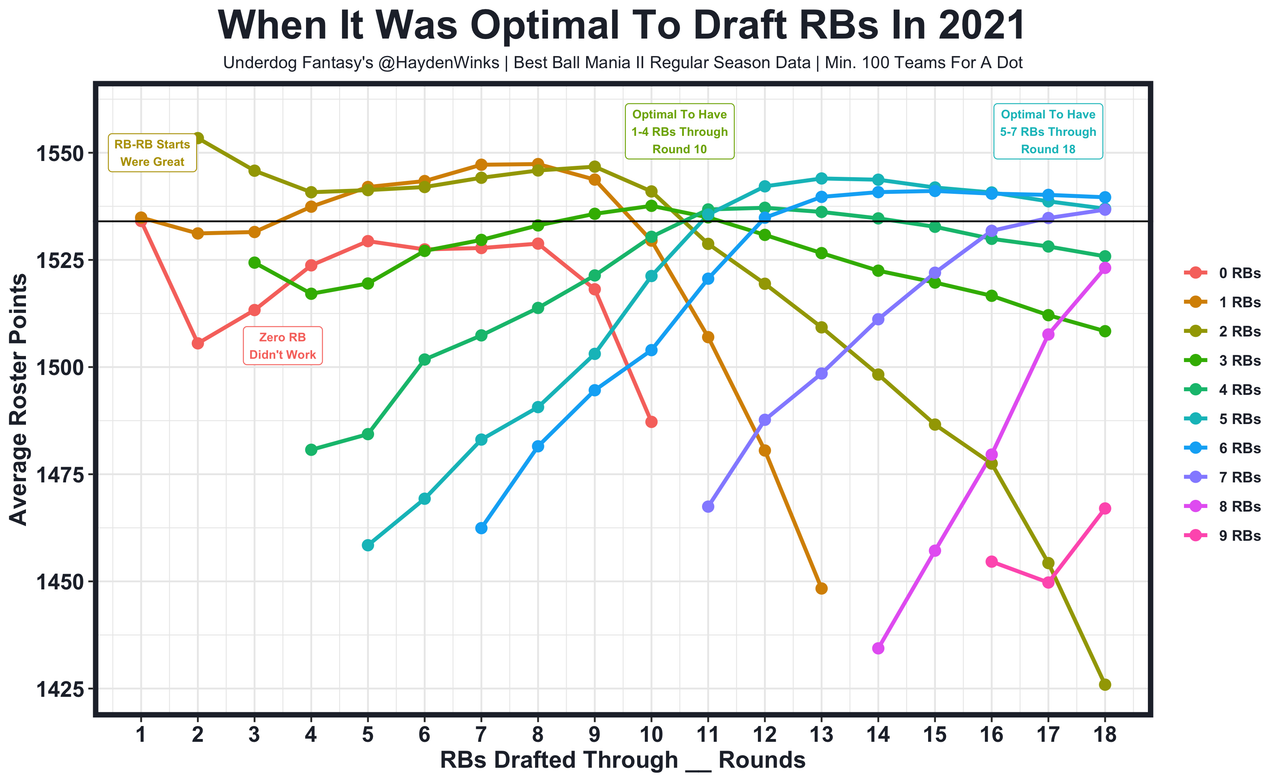
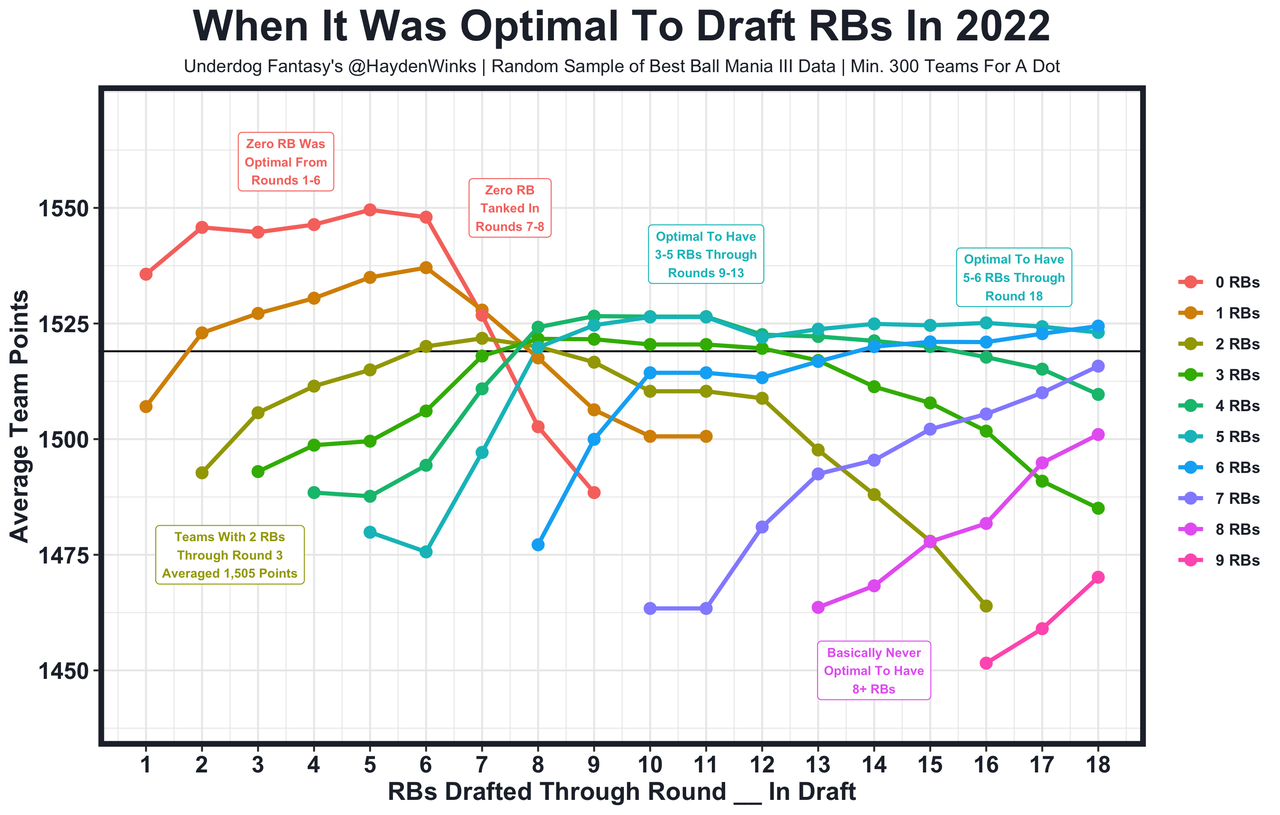
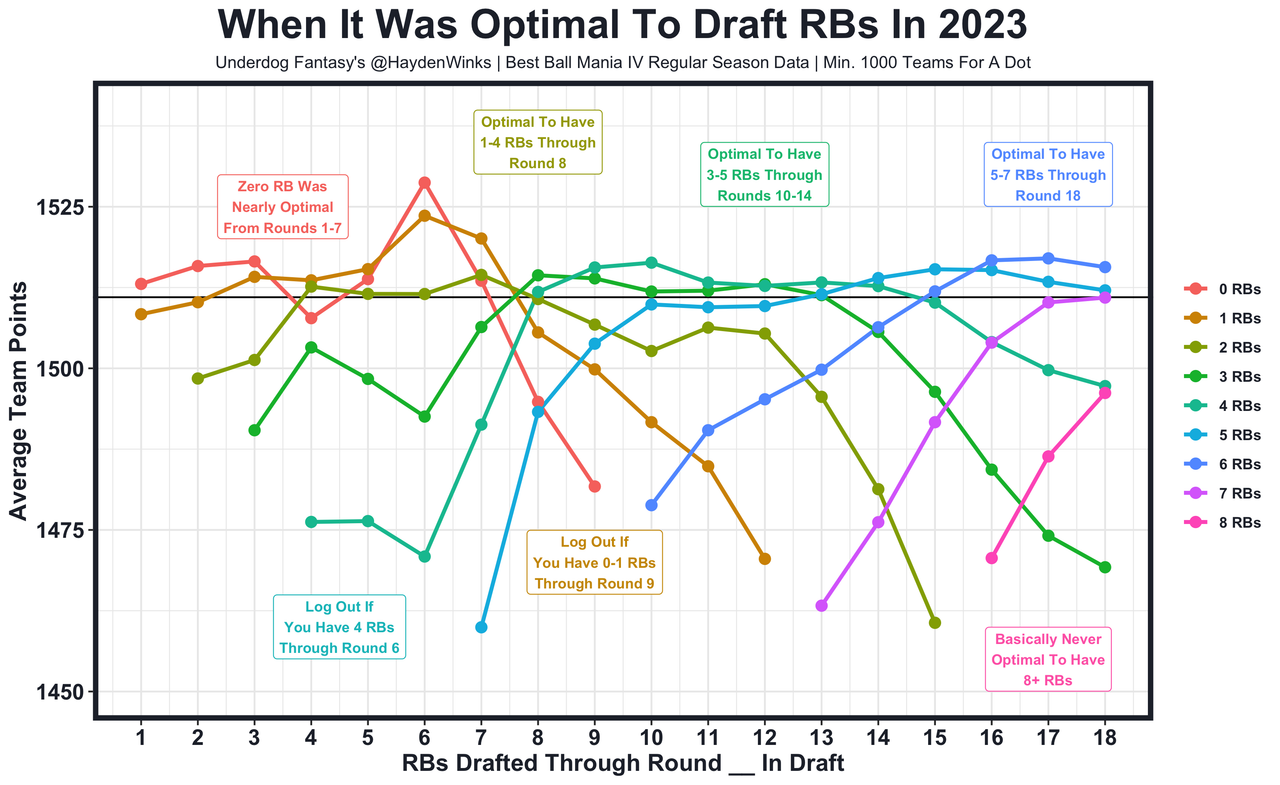
What Has Worked For Fantasy TEs...
Predicting When Travis Kelce Is Him... In BBM1 and BBMIII, Travis Kelce was very good. In BBMII and BBMIV, he wasn't. That summarizes if elite TE was worth it or not. Because there are so few true elites at this position, there will not be a trend of whether we should be drafting an elite TE or not. Instead, we'll have to look at the individual player projections each year to see if we have a Hall Of Famer in their prime or not.
Having 0-1 TEs Through Round 9... "Bully TE" (2 early TEs) can work in theory, but it has been a very below-average strategy in all 4 years. Instead, the highest scoring teams have either punted TE entirely or stuck with their TE1 until the double-digit rounds. Exactly when teams should have their TE2 has varied each year, ranging from Round 10 to Round 17.
Having 2-3 TEs Through Round 18... The teams with 3 TEs have averaged the most regular season fantasy points in all 4 seasons, but the 2-TE teams have been very close each year. The difference is negligible. Like other positions, whether we should drafted a 3rd TE or not depends on how good our other TEs are. If they are bad, then drafting a TE3 is smart, especially because this is the position that has the most week-to-week and season-to-season volatility. In fact, a 4-TE build averaged more than a 2-TE build in BBMII. Meanwhile, 1-TE teams have bled 25ish regular season points, which is typically more than the difference between 2nd and 3rd place finishers in a regular season pod.
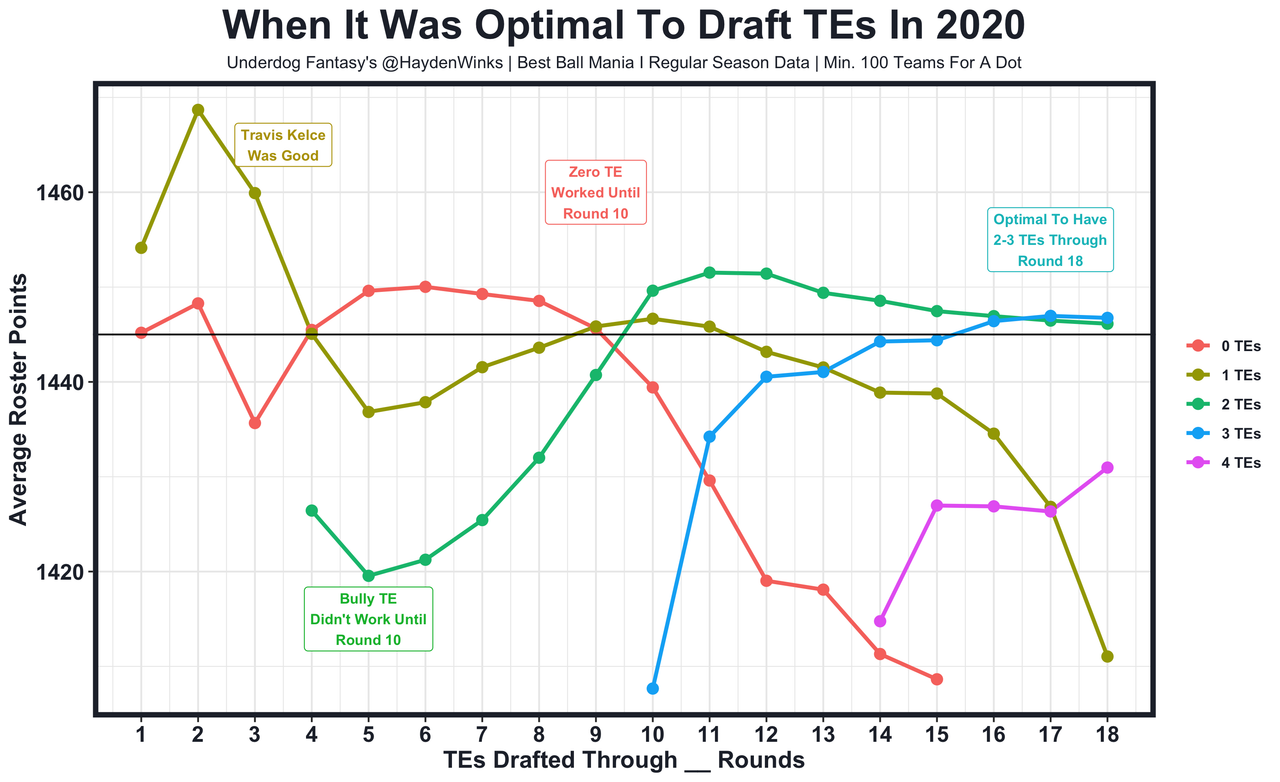
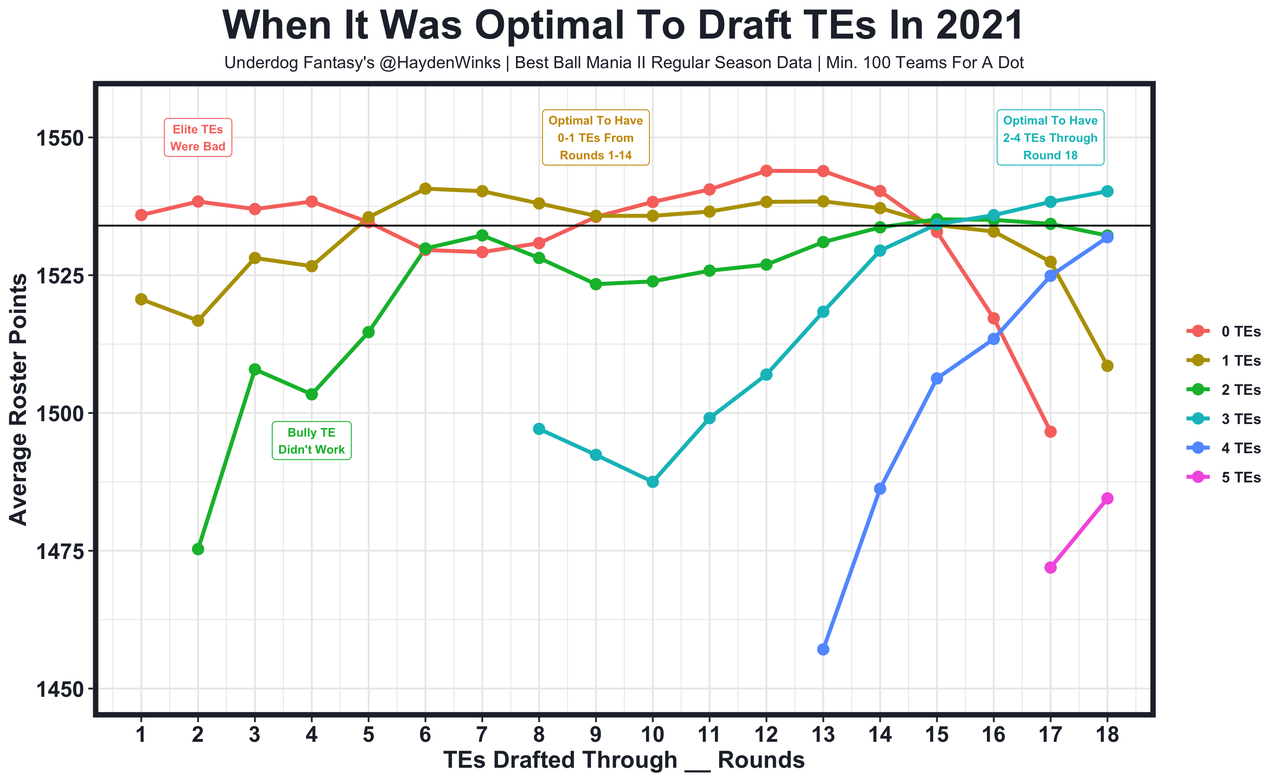
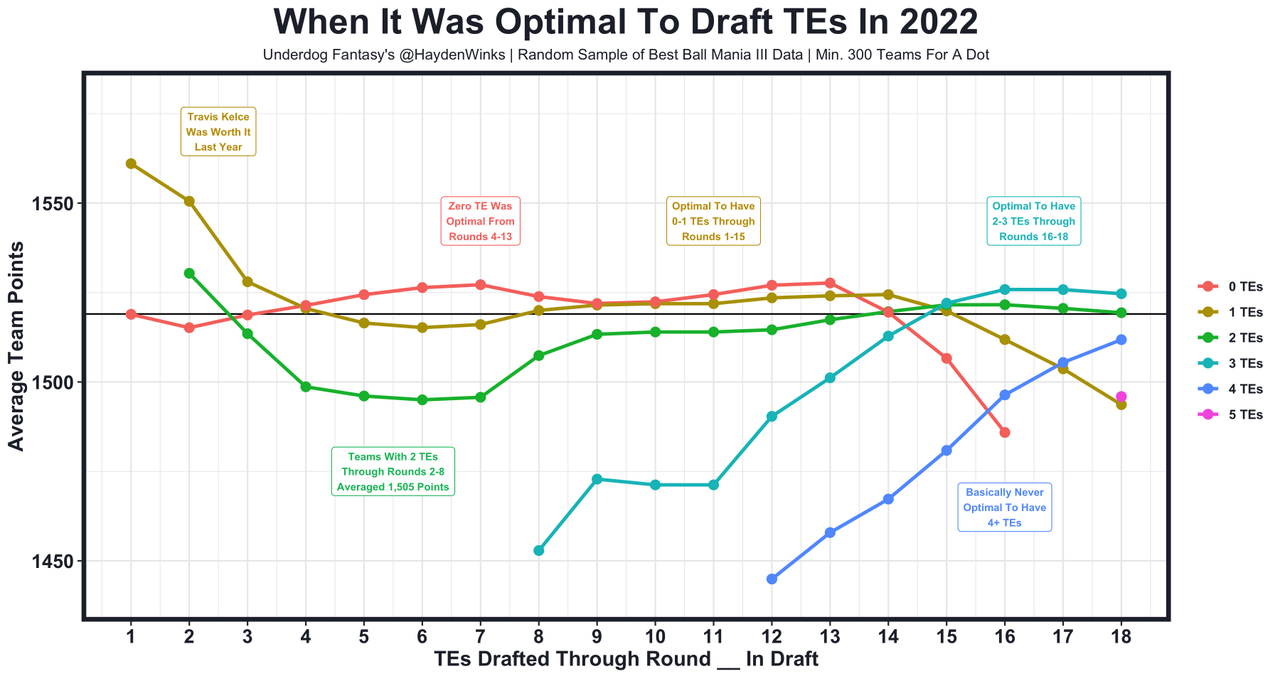
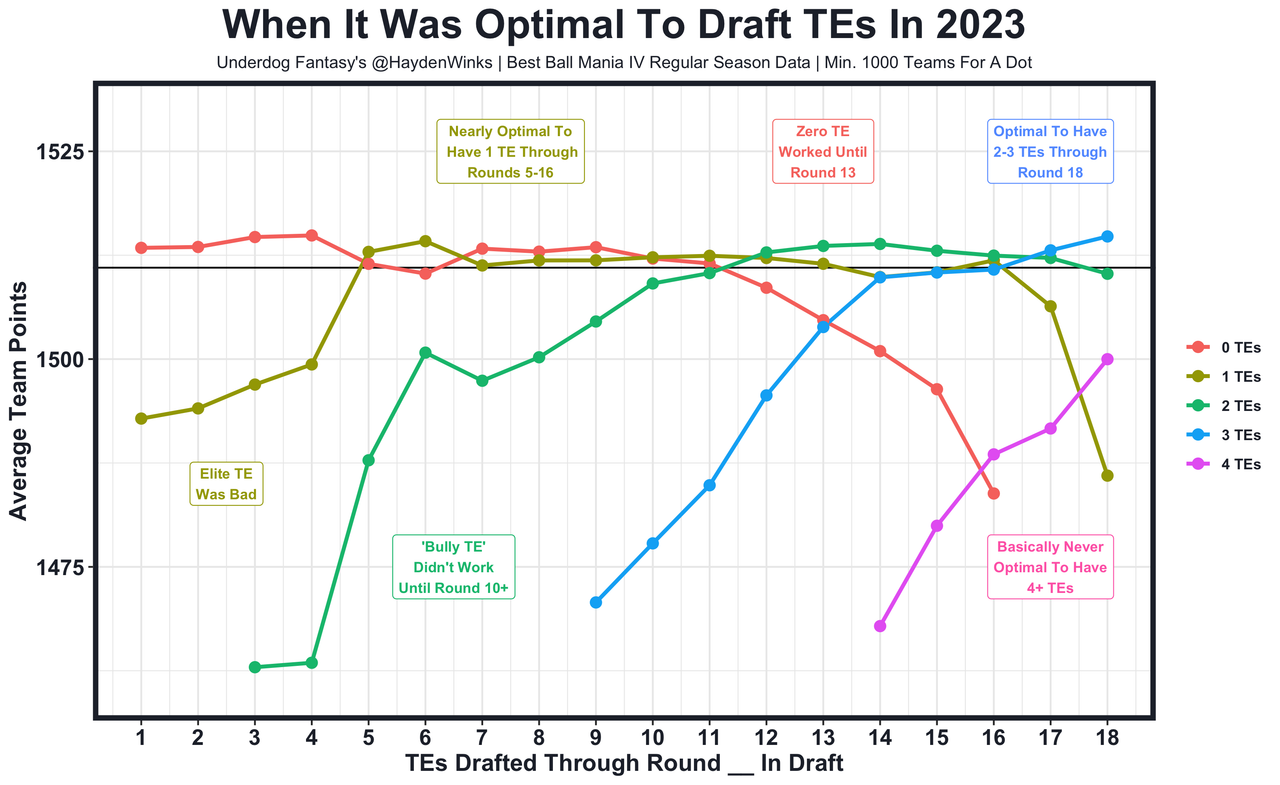
What Has Worked For Fantasy QBs...
Drafting A QB1 Before Round 14... Like we discussed in the TE blurbs, there isn't a clear trend on if we should draft elite QBs or not. Teams with 1 QB in Round 3 and Round 4 have averaged more regular season points than 0-QB builds in 3 of the last 4 seasons, but when Lamar Jackson busted in BBMI, that wasn't the case. Our upcoming season player projections will determine if we should draft an early QB or not. Meanwhile, the breaking point when going Zero QB has been Round 14 at the very latest. BBMIV may be the craziest injury season at QB, yet teams still wanted an elite QB or their QB1 by Round 14. In normal injury years, the drop-off of Zero QB has been Round 11.
Waiting Until Round 8+ To Draft A QB2... Double elite QB was fine in BBMII and BBMIII but was a total disaster in BBMI and BBMIV. When to draft a QB2 will depend on upcoming player projections, but it's been an okay to good strategy starting in Round 8-11 range typically. I wrote a column on this here.
Waiting Until Round 16+ To Draft A QB3... It's been totally optimal to have 2 QBs in two years and totally optimal to have 3 QBs in the other two years of Best Ball Mania. Drafting a QB3 or not will depend on the upcoming season projections and how early we drafted our QB1 and QB2. If we do opt for a QB3, then it's been best to wait until Round 16-18. I especially like this strategy early in offseasons when we can more comfortably project fantasy points from these QBs than the highly uncertain RBs and WRs that are drafted in the very last rounds.
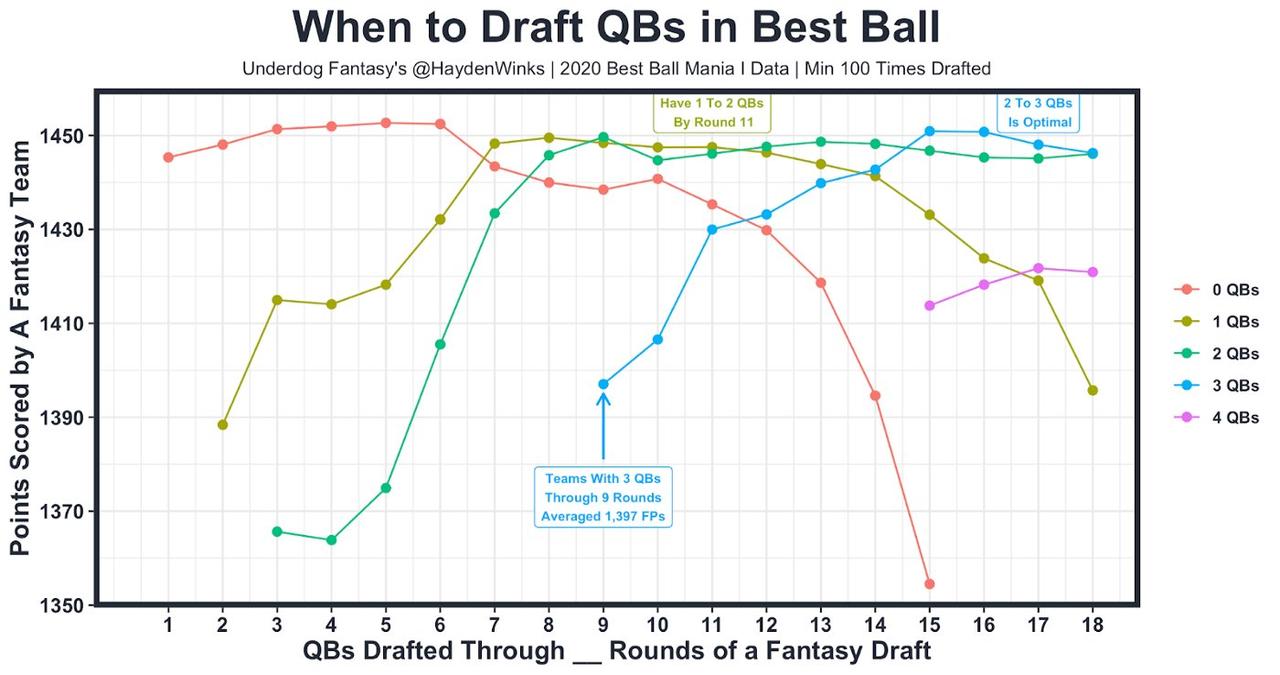
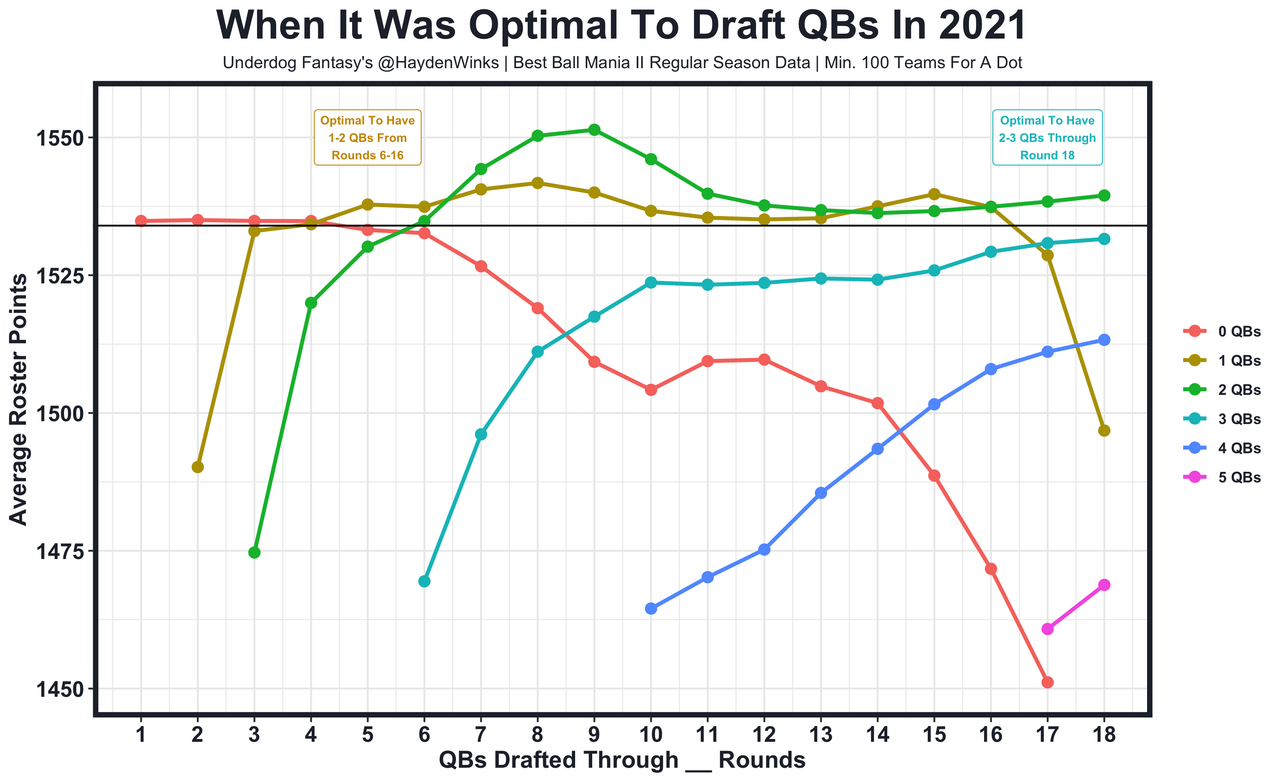
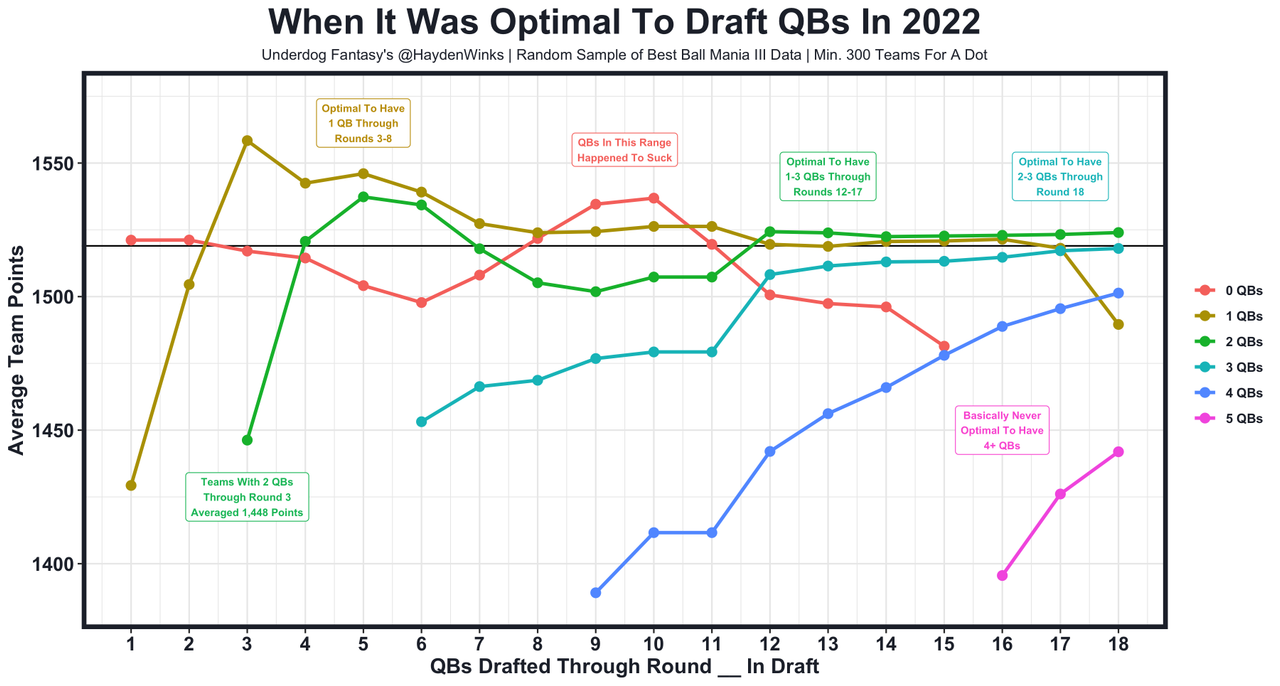
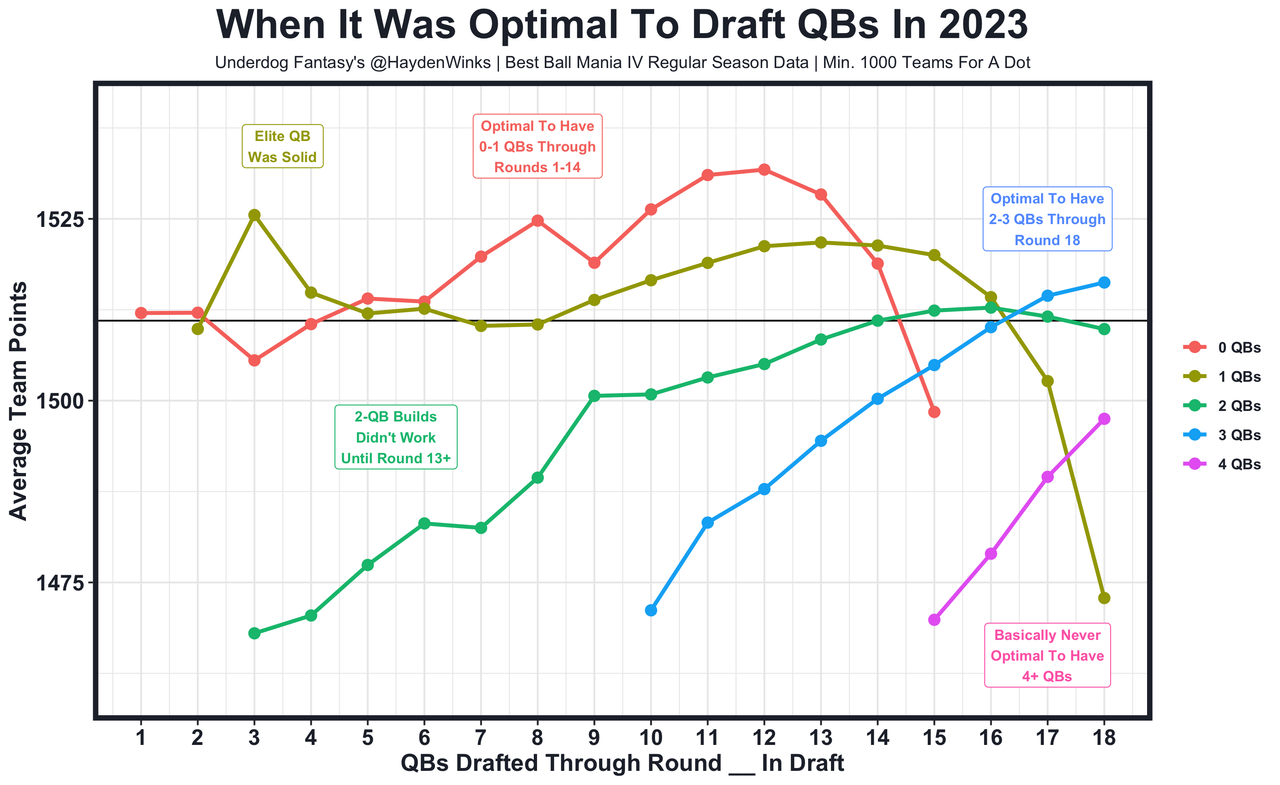
What Doesn't Work In Fantasy Football
Reaching For "Your Guys"... Because the "wisdom of the crowds" is generally so good, we're best off sticking around ADP. Teams that continuously reach 5+ spots in ADP lose points every year, while teams that scoop up ADP value are gaining points every year. This does not mean we can't have player takes. It just means that even if we really like a player, it doesn't give us permission to draft him a round early every single time. We can easily get to 20-33% of a player if we only draft them within 5ish spots of their listed ADP. I wrote about reaching in detail here. There's some cool charts and concepts. In fact, I think some of these concepts (like odds a player will be available by your next pick) will turn into best ball tools shortly.
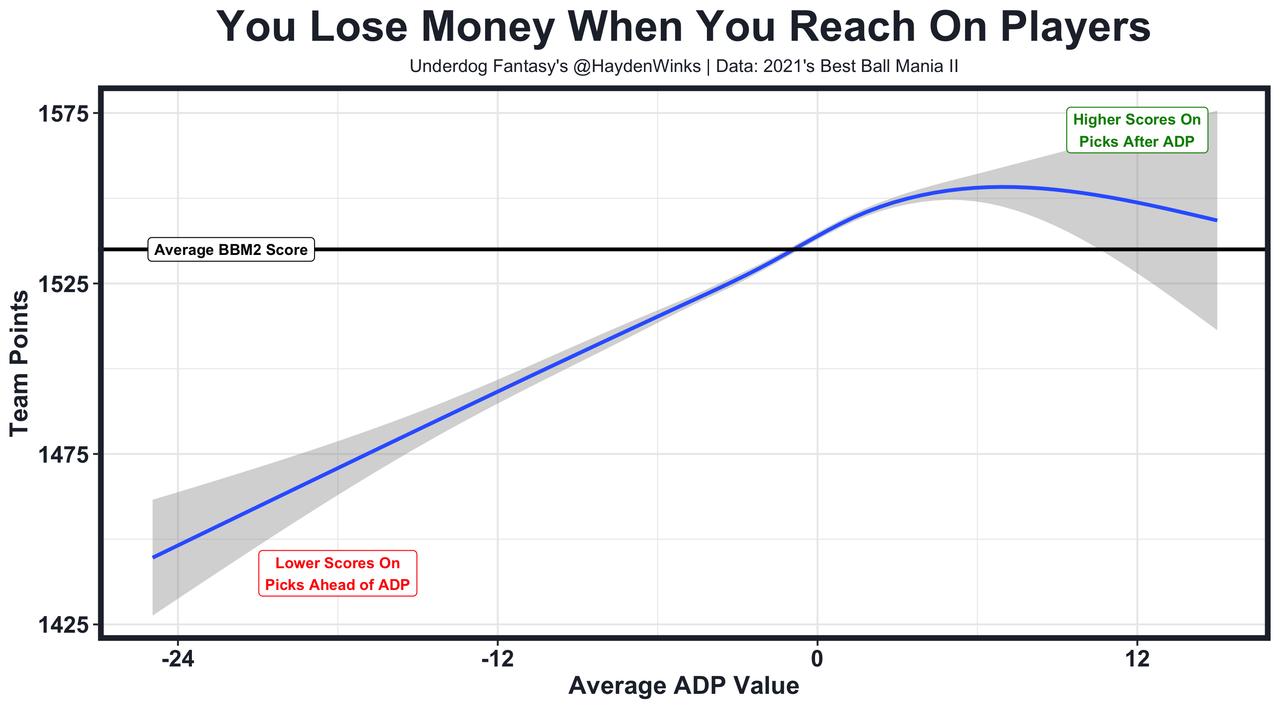
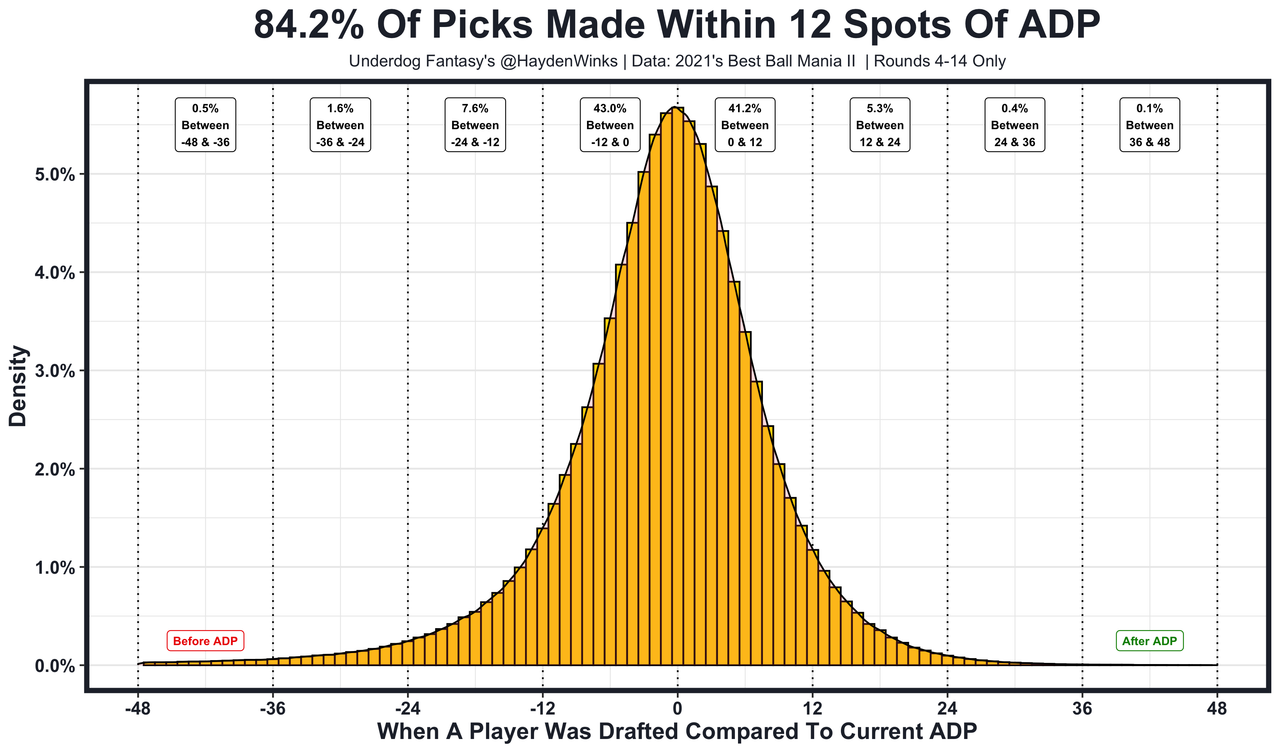
Galaxy-Braining Roster Construction... I want to be careful here because there are a couple ways that pushing the limits of roster construction can be advantageous when done properly, but generally, if your team looks really uncommon, then it's bad. Another win for the wisdom of the crowds. What the chart below shows is that the more common a roster is built, the more likely it is to produce above-average fantasy points. When a strategy is implemented just 0-5% of the time, it's usually bad. For example, the 2% of teams that drafted 4 RBs through Round 6 last year only averaged 1,471 points, which is notably different than the 1,511-point average team. If you're trying to get unique, then there are other ways to do so without risking roster construction failures. I wrote about Uniqueness Strategy in this 2022 column that had some of my favorite charts I've ever built.
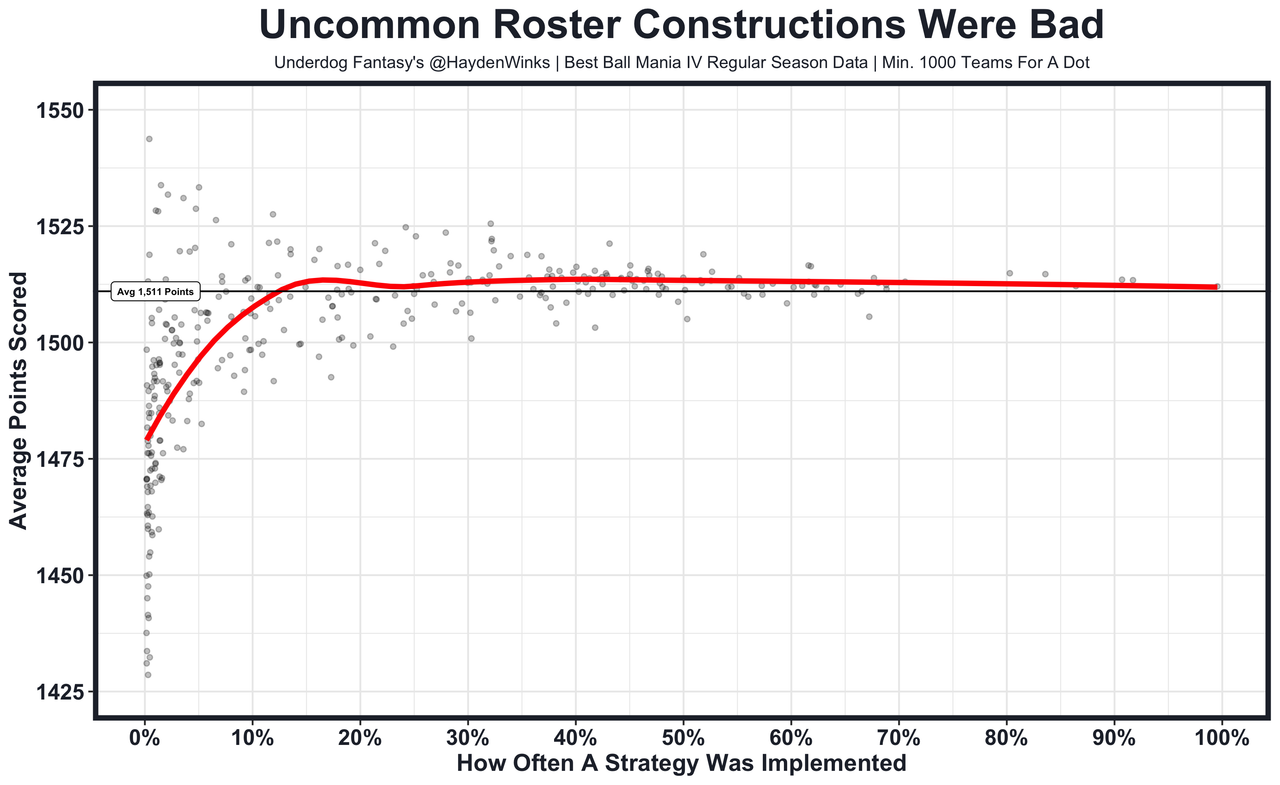
Scrolling too far down the board... I love a quality scroll down because there are slight advantageous in the best ball playoffs of having a low-drafted player, but we have to be careful on how we execute things. Luckily, there are dozens of players who are under 50% drafted who also project for some level of fantasy value. Their ADPs are in the 200 to 214 range. This cohort typically adds as many fantasy points to a best ball roster as players with an ADP of 180 to 199, yet are drafted far less often. When I'm on the clock in the 170s, 180s, and 190s, I'm often scrolling down to the 200s to leverage the drafted rate... But here's the catch: Once we get to players with an ADP of 215.0+, then they have very low odds of contributing. This has played out every year. You can decide if there's a meaningful difference between 1% drafted and 10% drafted, but historically the 10% drafted players actually contribute. Once again, wisdom of the crowds wins.
